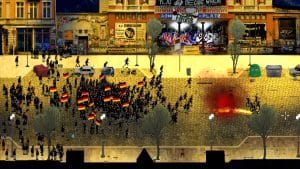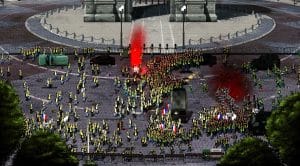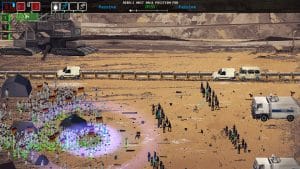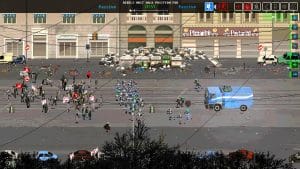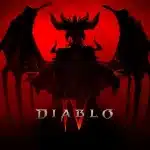RIOT: Civil Unrest
Related Games
Description
🔥 What is RIOT: Civil Unrest for PC
RIOT: Civil Unrest is a politically charged real-time strategy simulation developed by Leonard Menchiari and published by Merge Games, offering a unique look into the chaos of modern civil disobedience. Designed to immerse players in the tension and unpredictability of protests around the world, the game challenges moral, tactical, and emotional boundaries through interactive storytelling and reactive systems. Inspired by real-life events such as the Arab Spring, the Indignados movement, and the protests in Greece and Italy, RIOT transforms social commentary into a visceral interactive experience.
Players can choose to take control of either protesters or law enforcement, with each side having distinct objectives, challenges, and emotional undertones. As the leader of the crowd, you’ll decide whether to use peaceful negotiation, aggressive confrontation, or strategic manipulation of the environment to achieve your goals. Every decision you make affects not only the outcome of each conflict but also how the media and public opinion perceive your actions, adding layers of depth to what might at first appear to be a pixel-art RTS.
More than a traditional game, RIOT: Civil Unrest positions itself as an interactive experiment in empathy and perspective. It explores the social, ethical, and human cost of resistance and control, making players question their understanding of justice, power, and violence. It’s an artistic statement disguised as a tactical game a modern reflection on a world in constant turmoil.
👉 Features of RIOT: Civil Unrest
Dual Perspectives: Protesters vs Police
RIOT allows players to experience both sides of the conflict, providing a deep and often uncomfortable insight into the mechanics of power and resistance. Playing as the protesters, you must rally crowds, manage morale, and respond dynamically to police pressure while maintaining order and avoiding chaos. Conversely, as the police, your duty is to restore peace, using tactics that range from negotiation and containment to riot shields and tear gas.
The brilliance of this duality lies in its refusal to present clear heroes or villains. Each scenario forces players to interpret ethics through action, revealing how both sides are trapped within systems of fear and control.
Real-World Inspired Scenarios
The game features dozens of missions based on actual protests across multiple continents, including Italy’s NoTAV movement, Spain’s Indignados, and Egypt’s Tahrir Square uprising. Each location has been carefully recreated using detailed research and firsthand footage to ensure authenticity.
These scenarios don’t just serve as backdrops they actively inform gameplay mechanics and environmental factors. The layout of the streets, the behavior of the crowd, and the media’s reaction all affect your strategy and the eventual outcome of the protest.
Dynamic Crowd Simulation
One of RIOT’s core strengths lies in its advanced crowd AI system, which simulates thousands of individual participants reacting in real time. People run, scatter, throw objects, or chant slogans based on morale, leadership, and situational tension. No two confrontations ever play out the same way, as each AI unit acts according to a combination of fear, courage, and crowd psychology.
This simulation adds unpredictability and realism to every encounter. The crowd feels alive, shifting from organized resistance to chaotic panic in seconds if leadership falters or emotions flare.
Stylized Pixel Art and Atmospheric Design
RIOT’s visual style is minimalist yet emotionally charged, using hand-crafted pixel art to convey intensity and confusion rather than detailed realism. The grainy visual texture mirrors the volatility of amateur protest footage, blurring the line between game and documentary.
Lighting, smoke, and particle effects create a striking contrast between beauty and destruction. The explosions of color during clashes feel almost cinematic, emphasizing the surreal nature of real-world unrest.
Impactful Sound and Music
The game’s soundtrack, composed by Mattia Tripoli, heightens tension through distorted electronic tones and rhythmic pulses that reflect the escalating tempo of violence and fear. Sound effects from chanting crowds to the crack of rubber bullets immerse you directly in the chaos.
Voice snippets and ambient noise enhance immersion further, creating the sensation of standing in the middle of a roaring, unpredictable crowd. Each sound carries emotional weight, influencing player behavior subconsciously.
Gameplay
Strategy and Emotion in Real Time
RIOT: Civil Unrest is not a game about victory it’s a game about control, perception, and consequence. You direct squads, manage morale, and decide how to escalate or de-escalate conflict using real-time tactical decisions. The protesters must coordinate movements, avoid encirclement, and maintain unity, while police forces must prevent escalation without losing public support.
Each action—deploying tear gas, building barricades, or holding formation shifts the balance between chaos and order. Unlike standard RTS titles, RIOT is about influence rather than domination. The true challenge lies in managing fear, chaos, and public opinion simultaneously.
Campaigns and Sandbox Mode
The campaign mode offers structured missions based on specific protests, guiding players through both sides of international events. These missions feature unique environmental layouts, objectives, and narrative framing, providing educational and reflective context rather than straightforward progression.
The sandbox mode, however, lets you craft your own chaos. You can experiment freely with various settings, difficulty levels, and crowd behaviors, exploring how tiny adjustments such as deploying fewer riot shields or starting a protest at night completely transform outcomes.
Tactical Tools and Unit Management
Both factions have access to distinctive tools that shape their tactical identity. Protesters use megaphones, banners, fireworks, and molotovs, while police forces deploy armored vehicles, stun grenades, and water cannons. Unit management is crucial, as losing morale can dissolve formations or cause uncontrollable stampedes.
The interface is minimalist yet informative, keeping your focus on the chaos rather than micromanagement. Learning to read the shifting behavior of the crowd is essential for survival and success.
Graphics
Gritty Pixel Art with Documentary Realism
RIOT embraces a visual identity that feels both raw and artistic. Every frame appears intentionally imperfect, as if captured from shaky handheld footage. The combination of pixel-level simplicity and dynamic effects conveys the sense of confusion inherent in real protests.
This design choice is not just aesthetic it’s ideological. By stripping away realism, the game forces you to fill in emotional gaps yourself, amplifying empathy and discomfort. The streets look familiar yet abstract, mirroring the blurred morality of real-world conflicts.
Lighting, Smoke, and Motion
Particle effects, lighting transitions, and volumetric smoke transform otherwise static pixel environments into living, breathing battlegrounds. The haze of tear gas, the flicker of flares, and the pulsing of police lights all combine to build an atmosphere that feels charged and unpredictable.
Animations, though simple, carry surprising weight. The moment a crowd surges forward or a police line breaks feels viscerally impactful thanks to the way motion is conveyed through grouped behavior rather than individual animation detail.
Sound-Driven Visual Feedback
Visual feedback is tightly linked to sound design each explosion of noise, chant, or siren changes how the scene feels visually. The colors pulse with the rhythm of sound, and flashes of light respond dynamically to environmental chaos.
This cohesion between sight and sound creates a cinematic flow that elevates RIOT above typical indie simulations. The presentation constantly reminds the player that they’re both observer and participant in a larger, uncontrollable system.
Pros and Cons
✔️ Pros
- Unique real-time simulation of protests and crowd behavior rarely explored in games.
- Dual perspective system provides moral complexity and emotional engagement.
- Authentic real-world settings researched and designed with documentary precision.
- Atmospheric pixel art and sound design evoke tension and empathy effectively.
- Sandbox mode allows creative experimentation with mechanics and moral outcomes.
❌ Cons
- Limited tutorialization makes early missions confusing for new players.
- Some controls feel clunky during intense crowd movements.
- Missions can become repetitive due to similar objectives across regions.
- Occasional performance drops when simulating very large crowds.
ℹ️ Game information
⭐ Installation Instructions
- The game is fully complete, you just need to install it, so there is no need to unpack it or download it from other sources.
- Just run the RIOT: Civil Unrest.exe installation file.
- Simply launch the game from shortcut desktop.
⚙️ System Requirements
v✅ Minimum:
- OS: Windows 7/8/10 64bit
- Processor: AMD Athlon II X2 series / Intel Pentium Dual-Core G600 series
- Memory: 4 GB RAM
- Graphics: AMD R7 265 / NVIDIA GeForce GTX 650
- DirectX: Version 9.0c
- Network: Broadband Internet connection
- Storage: 3 GB available space
✅ Recommended:
- OS: Windows 7/8/10 64bit
- Processor: AMD FX 6000 series / Intel Core i3 4000 series
- Memory: 8 GB RAM
- Graphics: AMD Radeon R9 380 / NVIDIA GeForce GTX 960
- DirectX: Version 9.0c
- Network: Broadband Internet connection
- Storage: 3 GB available space
Images
